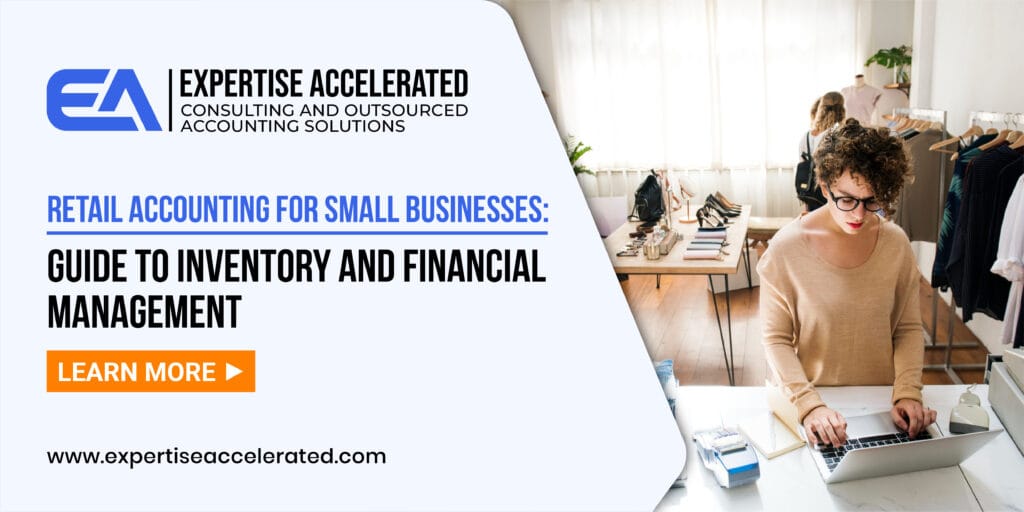Accurate financial records are vital for retailers, helping with inventory and cost management. Success in retail needs more than great products; it requires firm financial management. Small businesses meet challenges such as tracking sales, handling inventory, and taxes. Effectual retail accounting provides smooth operations and profitability.
According to Business Dasher, Sixty percent of small business owners believe they don’t know adequate accounting.
This blog covers retail accounting, tracking, inventory costs, and best practices.
What is Retail Accounting?

Retail accounting is a method used by retailers to value inventory. Unlike traditional accounting, it focuses more on managing inventory than calculating costs. Retail accounting estimates inventory value by assuming uniform pricing and consistent price changes. This simplifies calculations and reduces the need for physical stock counts. Retail accounting works best for businesses with stable pricing structures.
Pros and Cons of Retail Accounting
| Pros | Cons |
| 1.Makes inventory management easier, especially for businesses with many locations. | 1. Price changes can lead to inaccuracies since retail accounting assumes consistent pricing. |
| 2. Assumes uniform pricing, speeding up inventory valuation and financial statement preparation. | 2. Provides approximate inventory values, which may not be suitable for businesses that need precise data. |
| 3. Reduces the need for frequent stock counts, saving time and labor costs. | 3. Assumes constant markup, which can distort figures during sales or discounts. |
Calculating Inventory Costs with Retail Accounting
To track revenue and profit, it’s important to calculate the cost of goods sold and remaining inventory. Retail businesses use one of three costing methods. To explain these methods, let’s consider an example:
Suppose you own a game store selling dice. You buy thirty dice at 5¢, twenty-five at 7¢, and fifteen at 10¢. That totals 70 dice, but when tracking inventory, only 20 remain. How do you calculate the cost of the 50 dice sold?
Here are a few common ways:
- FIFO (First In, First Out): Believes that the first items purchased are the first sold. For instance, if you sell reasonable dice first, you compute the cost of the first 30 dice sold at 5 cents each and the subsequent 20 dice at 7 cents each.
- LIFO (Last In, First Out): The method believes that the most recently bought items sell first. If the most recent dice sale sells first, you compute the cost of the final items bought and deduct that from the total cost.
- Weighted Average: This method applies the whole cost across all articles. For instance, if you buy seventy dice for a sum of $5, you split the total cost by the number of dice to get an average cost of 7 cents per dice.
Inventory: Retail Method
The retail method is an easy way to compute the COGS and ending stock, mainly for products with a constant markup. You compute the cost-to-retail ratio by separating the product cost by the selling price. Then, deduct the sales total multiplied by this percentage from the cost of goods sold to see the ending inventory.
For example, if you buy chess sets for $75, and sell them for $100, so cost-to-retail is 75%. With a $3k total inventory, multiply by 75% to get $2,250. Subtract from $3k to get an ending inventory of $999.
Tracking Inventory Amounts
To ensure you meet customer demand and keep accurate records, tracking inventory is key. This helps with sales and tax accounting.
Tip: A Point of Sale (POS) system can track inventory without needing manual counts.
Here are methods for tracking inventory in retail accounting:
- Perpetual Method The perpetual method tracks inventory using a POS system. As you receive and sell items, the system updates your stock. While it saves time, it’s important to still do manual counts for non-sale losses like damaged goods or theft.
- Periodic Method If you can’t afford a POS system, the periodic method involves counting inventory on a set schedule (weekly or monthly). This method requires more effort and doesn’t track what’s sold or lost.
Example of Retail Accounting

You own a hardware shop with a 30% markup, starting inventory of $100,000, $50k in sales, and $5k in new stock. To calculate inventory value:
- Initial inventory: $100,000
- New inventory purchases: $5,000
- Total inventory cost: $105,000
- Sales with markup: $50,000 * 30% = $15,000
Deduct the markup sales from total inventory cost: $105,000 – $15,000 = $90,000. This is your calculated inventory value using retail accounting.
Accounting 101 for Retail Businesses
Successful accounting is vital for any business. Retail businesses must maintain proper financial records. There are three fundamental financial statements you’ll require.
- Income Statement
An income statement tracks your business’s revenue, from product sales. You deduct the COGS to decide the profit left for covering overhead costs such as rent, wages, and utilities. This statement shows how much you gained over a specific period, enabling you to understand if your business is advantageous.
- Balance Sheet
A balance sheet is a picture of your business at a single point, unlike an income statement which covers a time (week, month, or year).
A balance sheet tracks you:
- Assets are what you own (e.g., equipment, stock).
- Equity is the business value after subtracting liabilities from assets.
- Liabilities are what you owe (e.g., loans, credit card debt).
- Cash Flow Statement
This statement records the actual cash that enters and leaves your business. Contrary to the income statement, which tracks sales, the cash flow statement concentrates on actual payments. For instance, it registers when you obtain money from a sale, even if you sold on credit. This helps confirm you have adequate cash on hand to operate your business.
Accounting Software for Retail
Accounting can be difficult, but using accounting software can make it simple. These tools track finances, control inventory, and create invoices, and statements. They also incorporate your Point-of-Sale system, making it manageable to keep track of sales and stock. Popular accounting software includes QuickBooks Online and Xero.
Retail Accounting Best Practices
- Stay informed on industry changes that affect your finances.
- Use reliable tools to track your sales, purchases, and expenses to avoid errors.
- Choose an inventory valuation method and stick with it to ensure transparency and consistency.
- Use financial data to make informed decisions about pricing, stock levels, and business growth.
Choosing the Right Accounting Method
Different accounting methods suit different types of businesses:
- The average cost method is efficient for businesses with high inventory turnover.
- FIFO or LIFO are better for businesses with significant inventory fluctuations.
- Consulting with an accountant is important for industries with specific accounting rules.
Conclusion
Retail accounting is vital for tracking your financial health. Using the right accounting methods and keeping accurate records helps manage your finances. Investing in good software can help avoid errors and keep your business profitable.
Expertise Accelerated makes retail accounting easy. It automates jobs to save time and allows your team to concentrate on clients. You can track inventory in real time, fix up automatic orders, and obtain low-stock signals. All your financial jobs, such as payroll and expenses, are in one place. The software provides key data and reduces mistakes, helping you make better decisions. Expertise Accelerated helps your business run smoothly, so you can focus on growing it.


